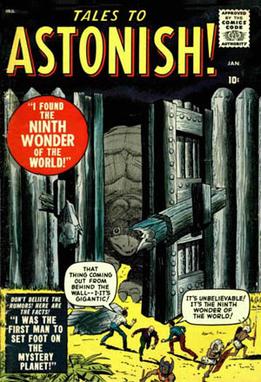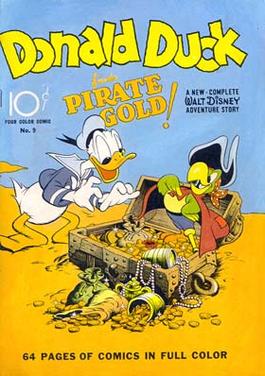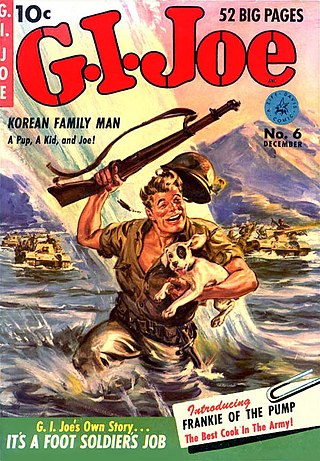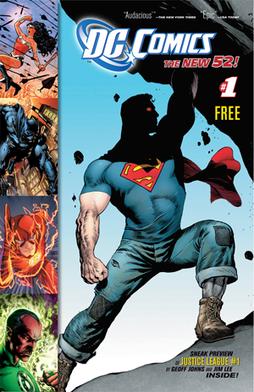
Vertigo Comics was an imprint of American comic book publisher DC Comics started by editor Karen Berger in 1993. Vertigo's purpose was to publish comics with adult content, such as nudity, drug use, profanity, and graphic violence, that did not fit the restrictions of DC's main line, thus allowing more creative freedom. Its titles consisted of company-owned comics set in the DC Universe, such as The Sandman and Hellblazer, and creator-owned works, such as Preacher, Y: The Last Man and Fables.

The Topper was a UK comic published by D. C. Thomson & Co. Ltd that ran from 7 February 1953 to 15 September 1990, when it merged with The Beezer.

All-American Comics was a comics anthology and the flagship title of comic book publisher All-American Publications, one of the forerunners of DC Comics. It ran for 102 issues from 1939 to 1948. Characters created for the title, including Green Lantern, the Atom, the Red Tornado, Doctor Mid-Nite, and Sargon the Sorcerer, later became mainstays of the DC Comics line.

Tales to Astonish is the name of two American comic book series, and a one-shot comic, all published by Marvel Comics.

Four Color, also known as Four Color Comics and Dell Four Color, was an American comic book anthology series published by Dell Comics between 1939 and 1962. The title is a reference to the four basic colors used when printing comic books. The first 25 issues (1939–1942) are known as "series 1". In mid-1942, the numbering started over again, and "series 2" began. After the first hundred issues of the second series, Dell stopped putting the "Four Color Comics" designation on the books, but they continued the numbering system for twenty years.

Youngblood is a superhero team that starred in their self-titled comic book, created by writer/artist Rob Liefeld. The team made its debut as a backup feature in RAMM #1 before the next month appearing in the one-shot Megaton Explosion #1 before later appearing in April 1992 in its own ongoing series as the flagship publication for Image Comics. Youngblood was originally published by Image Comics, and later by Awesome Entertainment. Upon Rob Liefeld's return to Image Comics, it was revived in 2008, 2012, and 2017. In 2019, Liefeld revealed that he has not owned the rights to Youngblood for several years.

Mort Todd is an American writer and media entrepreneur, best known as an editor-in-chief of Cracked magazine, and later, Marvel Music. He is owner of Comicfix, a media company that has developed licensed properties.
Razorline was an imprint of American comic book company Marvel Comics that ran from 1993 to 1995. It was created by filmmaker and horror/fantasy novelist Clive Barker, with its characters existing in one of the many alternate universes outside the mainstream continuity known as the Marvel Universe.

G.I. Joe has been the title of comic strips and comic books in every decade since 1942. As a licensed property by Hasbro, G.I. Joe comics have been released from 1967 to present, with only two interruptions longer than a year. As a team fighting Cobra since 1982, the comic book history of G.I. Joe: A Real American Hero has been covered by three separate publishers and four main-title series, all of which have been based on the Hasbro toy line of the same name.

Mickey Finn was an American comic strip created by cartoonist Lank Leonard, which was syndicated to newspapers from April 6, 1936 to September 10, 1977. The successful lighthearted strip struck a balance between comedy and drama. It was adapted to a 400-page Little Big Book and was reprinted in several comic book series throughout the 1930s and 1940s.
Vincent Sullivan was a pioneering American comic book editor, artist and publisher.

Gordon G. Rogers, better known as Boody Rogers, was an American comic strip and comic book cartoonist who created the superhero parody Sparky Watts.

The Skyman is a fictional comic book superhero that appeared stories during the Golden Age of Comic Books. Created by writer Gardner Fox and artist Ogden Whitney, the character first appeared in the Columbia Comics omnibus title Big Shot Comics #1. He is unrelated to the DC Comics character.

John Ogden Whitney was an American comic-book artist and sometime writer active from the 1930s–1940s Golden Age of comics through the 1960s Silver Age. He is best known as co-creator of the aviator hero Skyman and of the superpowered novelty character Herbie Popnecker and his alter ego, the satiric superhero the Fat Fury. Whitney as well had long runs on characters as diverse as the Western masked crime-fighter the Two-Gun Kid, and the career-girl character Millie the Model.

Columbia Comics Corporation was a comic book publisher active in the 1940s whose best-known title was Big Shot Comics. Comics creators who worked for Columbia included Fred Guardineer, on Marvelo, the Monarch of Magicians; and Ogden Whitney and Gardner Fox on Skyman.

Mickey Mouse is a Disney comic book series that has a long-running history, first appearing in 1943 as part of the Four Color one-shot series. It received its own numbering system with issue #28, and after many iterations with various publishers, ended with #330 from IDW Publishing.

The New 52 is the 2011 revamp and relaunch by DC Comics of its entire line of ongoing monthly superhero comic books. Following the conclusion of the "Flashpoint" crossover storyline, DC cancelled all its existing titles and debuted 52 new series in September 2011. Among the renumbered series were Action Comics and Detective Comics, which had retained their original numbering since the 1930s.
Keyhole Kate was a 1930s British comic strip series in The Dandy. The strip featured a nosy young girl who liked to look through people's keyholes. She appeared in The Dandy's first issue, drawn by Allan Morley back in 1937. She continued in The Dandy until 1955 and appeared as the cover strip of issue 295. She later appeared in the new Sparky comic released in 1965, alongside Hungry Horace another character who appeared in The Dandy''s first issue and was drawn by Morley. The character was featured alongside Hungry Horace on the front cover of the Sparky book from 1970 to 1972.
Cat-Head Comics was an American alternative/underground comics publisher that operated from 1980 to 1998. Founded by cartoonist Steve Lafler as a vehicle for his own work, Cat-Head was later joined by writer/poet/editor Stephen Beaupre. Cat-Head's longest-running title was the anthology Buzzard, which lasted 20 issues.

Marvel Legacy is a 2017–18 relaunch of a line of American comic books published by Marvel Comics. It is concurrent with All-New, All-Different Marvel and Marvel NOW! 2.0.
















